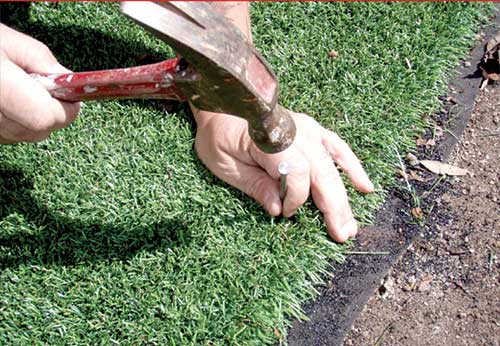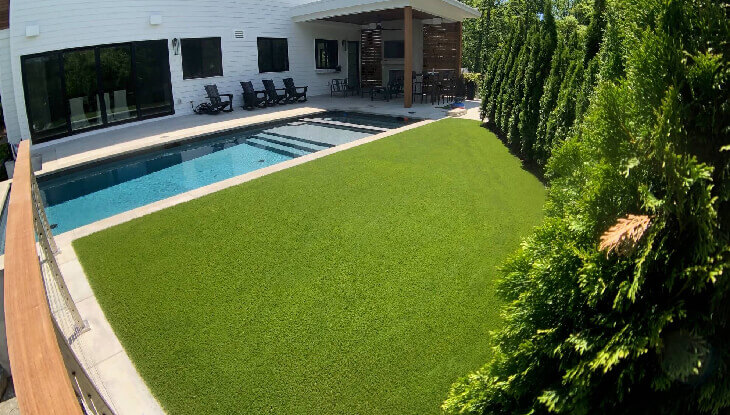Leading Turf Installation Canoga Park Companies for Homeowners
Leading Turf Installation Canoga Park Companies for Homeowners
Blog Article
Leading Reasons to Think About Artificial Lawn for a Rich and Low-Maintenance Lawn
As homeowners progressively look for sustainable options for exterior spaces, man-made yard presents an attractive choice to traditional yards. The benefits expand beyond simple appearances and sustainability; exploring the diverse ramifications of artificial lawn discloses a thorough approach to lawn monitoring that benefits deeper consideration.
Year-Round Greenery
Among one of the most substantial benefits of fabricated yard is its ability to provide year-round plant, despite environment problems. House owners commonly deal with difficulties in preserving a dynamic lawn due to seasonal changes, dry spells, or hefty rains. Fabricated lawn gets rid of these issues, guaranteeing a regularly lush look throughout the year.
This artificial alternative is engineered to hold up against diverse weather condition scenarios, from scorching summer season warm to freezing winter months temperature levels. Unlike natural grass, which might brown or come to be irregular during severe conditions, artificial lawn preserves its vibrant shade and structure, enhancing the visual appeal of any kind of landscape.
Furthermore, artificial lawn is resistant to parasites and illness that typically influence natural grass. This resilience adds to its enduring elegance, as there is no requirement for chemical therapies or fertilizers that can be unsafe to the setting. Property owners can appreciate the visual benefits of a properly maintained lawn without the cyclical obstacles posed by natural lawn treatment.
Reduced Maintenance Initiatives
Fabricated grass substantially lowers maintenance efforts, enabling house owners to enjoy a beautiful yard without the taxing jobs associated with natural turf care. One of one of the most remarkable benefits of artificial lawn is the elimination of regular mowing. With no requirement for a lawnmower, house owners conserve both time and the price of upkeep related to this tools.

Cleaning up artificial turf is simple; an easy rinse with a tube or the periodic cleaning to eliminate debris is usually enough - artificial grass canoga park. This ease of care enables property owners to spend more time appreciating their exterior rooms as opposed to struggling over them. In recap, the lowered upkeep efforts associated with artificial turf make it an attractive selection for those seeking a beautiful, hassle-free backyard
Water Preservation Conveniences
The considerable decrease in upkeep initiatives connected with synthetic yard includes water conservation, making it an ecologically pleasant choice for property owners. Conventional lawns need considerable amounts of water to stay lively and rich, usually bring about too much water usage, especially in deserts. In contrast, man-made grass gets try this out rid of the requirement for routine watering, drastically minimizing the general water usage in your lawn.
By choosing synthetic lawn, home owners can save countless gallons of water each year. This change not just benefits individual houses yet likewise adds to more comprehensive ecological efforts aimed at lowering water waste. In locations experiencing water scarcity, the fostering of man-made turf can play a significant duty in reducing the effects of dry spell and making sure that important water sources are used more successfully.
Additionally, the installation of man-made grass can aid lower metropolitan water demand, profiting the neighborhood as a whole. With growing recognition of environmental concerns, picking man-made grass functions as a proactive action towards sustainable landscape design, assisting to maintain natural water resources while maintaining a visually pleasing exterior space (backyard artificial grass). In summary, man-made yard presents an engaging remedy for water conservation, lining up ecological responsibility with contemporary landscape design demands

Pest and Allergy Decrease
A substantial benefit of setting up synthetic turf is its capacity to lower pests and irritants in outdoor rooms. Traditional yard lawns frequently act as reproducing premises for insects such as mosquitoes, ticks, and ants, which can develop discomfort and health threats for family members and family pets. In comparison, man-made lawn gets rid of the organic product that draws in these pests, therefore substantially lowering their populaces in your lawn.
Moreover, all-natural turf can nurture mold, plant pollen, and other irritants, which can activate allergies and breathing issues for delicate individuals. Artificial turf supplies a cleaner environment, lowering the potential for allergenic responses. Unlike natural lawn, artificial lawn does not produce plant pollen, making it an excellent choice for allergy patients looking for to enjoy their outside rooms without the danger of flare-ups.
In addition, the absence of dirt in artificial grass suggests there is less dust and dust, further lessening air-borne allergens. This low-maintenance option not just enhances the aesthetic charm of your backyard but likewise advertises a healthier outdoor atmosphere, permitting families to enjoy their yards without the consistent worry of irritants and parasites. Thus, man-made yard is a strategic option for those focusing on convenience and health in their exterior home.
Long-Term Cost Savings
Investing in synthetic turf can lead to significant lasting expense savings for property owners. Synthetic grass eliminates the demand for regular grass upkeep costs, such as mowing, fertilizing, and watering.
Moreover, the longevity of artificial grass better improves its cost-effectiveness. Many navigate here top quality artificial yard items can last 15 to 25 years with very little upkeep, lowering the requirement for replacement or considerable repair services. On the other hand, all-natural lawn may call for regular reseeding and regular treatment, which can rapidly build up in expenses.
Utility financial savings are one more critical variable. Property owners can anticipate to see lower water bills, as artificial turf does not need irrigation. Furthermore, the reduction in yard care services can release up important time and sources, enabling homeowners to allocate their budgets somewhere else.
Conclusion
In recap, artificial grass offers many benefits for homeowners looking for a low-maintenance and lively landscape. Eventually, the long-term expense savings connected with synthetic lawn solidify its standing as a practical and sustainable remedy for boosting exterior areas.
Artificial lawn dramatically lowers maintenance initiatives, enabling property owners to enjoy a beautiful yard without the lengthy jobs connected with natural turf treatment.The considerable reduction in upkeep efforts associated with man-made lawn expands to water conservation, making it an eco friendly alternative for home owners. In contrast, synthetic turf removes the requirement for normal watering, significantly minimizing the general water usage in your yard.
In locations experiencing water shortage, the fostering of synthetic grass can play a significant role in minimizing the results of dry spell and making sure that useful water resources are made use of more effectively.
With expanding awareness of environmental try this out concerns, picking synthetic yard serves as a positive action in the direction of sustainable landscape design, assisting to preserve natural water sources while keeping a cosmetically pleasing exterior area.
Report this page